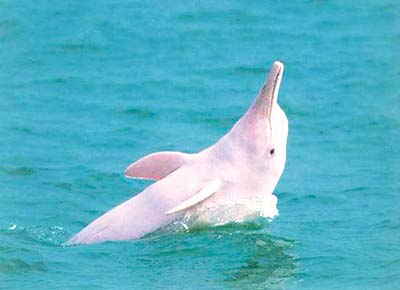White dolphins frolic again as eco-environment improves
Tourists throng to Xiamen, a world-famous resort in southeast China, for its seaside, sunshine and scenic cultural heritage sites. Now, Chinese white dolphins, as part of the city's oceanic landscape, may become the new sought-after attraction for tourists.
|
|
| File photo: Chinese white dolphin |
Xiamen is the only city in the world which allows people to see inshore dolphins on its beaches, whereas in other countries, such as Japan and Peru, people have to get to dolphins in the open sea after hours of ship-riding.
"In December, more than 30 dolphins appeared in one group in the Wuyuan Bay of Xiamen," Chen Bingyu, from the Xiamen Precious and Rare Marine Species Reserve Management Office, told Xinhua. "It's the first time in more than 20 years."
"In recent years, more and more dolphins have begun to appear in nearby sea areas," said Zhou Lumin, deputy chief of Xiamen Municipal Oceanic and Fishery Administration. "It's time for Xiamen to develop its dolphin-watching business."
The Chinese white dolphin, boasting the nickname of "giant panda in the sea" and living mainly in the sea areas around Xiamen and the Pearl River estuary in southern China, is a mammal guarded under the first-class state protection.
In the 1960s and early 1970s, it was not unusual for Xiamen citizens to enjoy watching groups of dolphins frolic in the sea.
"Unfortunately, the undue exploitation, pollution and consequent deterioration of the ecosystem around the area drove dolphins far away," said Chen.
As one of China's first four special economic zones, Xiamen has seen an unprecedented economic boom since 1980.
Twenty or thirty years ago, scenes of dolphins frolicking in groups faded out of sight and even out of mind of most Xiamen residents.
"The number of Chinese white dolphins is an important indicator for the ecological situation in the inshore sea areas," Zhou Lumin noted.
"Only when the oceanic ecosystem returns to normal, will the dolphin population rise again," Zhou added.
 0
0 







